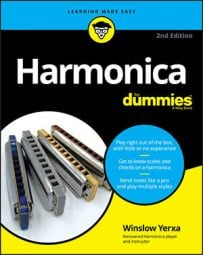While you create the bulk of your harmonica sound in your air column, your hands can affect the loudness of a note by opening and closing your hand cup around the harp. This action changes loudness — and the perception of loudness — in three related ways:
Rapid changes in tone color: When you change quickly between the dark sound of closed hands and the bright sound of open hands, the listener notices and will perceive your sound more readily, something like the way you notice a flashing light of an ambulance or firetruck in your rearview mirror more easily than you notice just another set of headlights.
The sound fanning effect: The extreme hand motions, such as the windmill and the elbow swing, have the effect of pushing sound waves out from the harmonica into the surrounding air.
The tuned chamber: Even hand enclosure will naturally amplify a specific note. By learning to size your hand chamber — and the opening in your hands — you can make a note sound louder, even when playing softly.
You can see how loudness is changed on the harmonica with the use of hand position in Chapter 6, Video Clip 0601.
Changing the tone color rapidly
Try changing tone color with your hands by following these instructions:
Hold the harmonica so that your hands completely enclose the back and sides of the instrument.
Start playing a note or a chord and listen for the dark sound you create when your hands muffle the high-frequency sounds that the harmonica generates.
Using your nonholding hand, flex your wrist to raise the heel of the hand away from the harmonica.
When you do this, you open a space for the high-frequency energy to escape, and the tone brightens.
Try going back and forth rapidly between the open and closed positions and listening for the effect you create.
Fanning the sound using your elbow
The farther and faster you move your nonholding hand to and away from the harmonica, the stronger an effect you’ll produce. This is where your elbow comes into play.
Try doing an elbow swing by pivoting your entire forearm from the elbow to move your hand to and away from the harmonica.
![[Credit: Illustration by Rashell Smith]](https://www.dummies.com/wp-content/uploads/456034.image0.jpg)
The most extreme way of changing between bright and dark is to rotate your entire forearm in a full circle, sweeping your cupping hand past the harmonica, momentarily darkening the sound, and then fanning the sound outward. Rock guitarists use a similar arm motion and often call it the windmill. Sonny Terry used this gesture occasionally when playing the harmonica.
![[Credit: Illustration by Rashell Smith]](https://www.dummies.com/wp-content/uploads/456035.image1.jpg)
Tuning your hand chamber to the note you’re playing
When you use both hands to cup the harmonica, you can make the note sound louder by changing the size of the enclosed area and the size of the opening between the edges of your palms. To experience the dramatic change in volume you can achieve, try this:
Hold the harmonica in both hands, with a slight opening between your hands.
Softly play a sustained note on Blow 6 and use your nonholding hand to very slowly close the opening between your hands.
As you change the shape of your hand cup, listen for a marked increase in volume.
When you try for this effect, it’s easiest to achieve on Blow 6. After you can find it on Blow 6, try it on some of the notes in nearby holes. This technique is not well known and isn’t obvious; in fact, it’s a little counterintuitive that you should be able to make the harp louder by covering it up. But it’s real — check it out.
You can gauge the effect of your hand opening on loudness by recording yourself as you try different hand openings and watching the volume go up and down on the recording meters.

